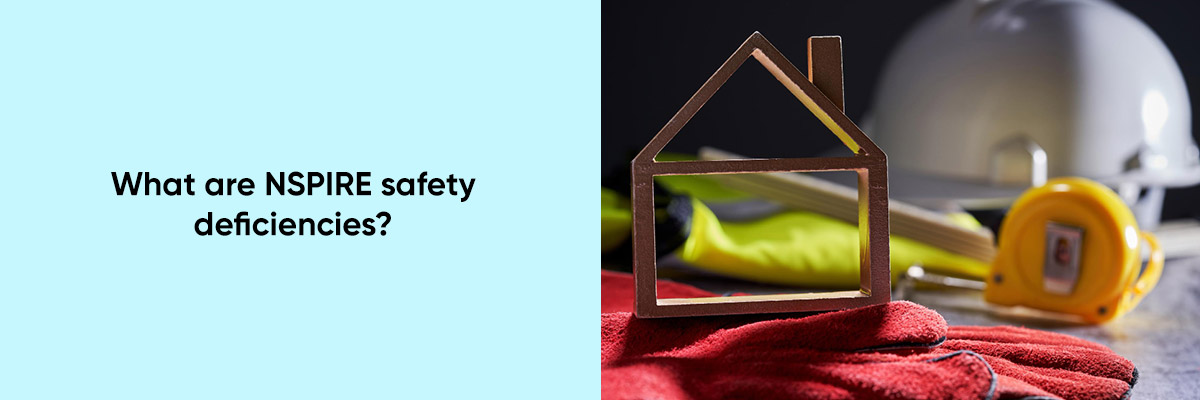Physical Inspection Standards for Housing (NSPIRE) are a comprehensive initiative launched by the U.S. Department of Housing and Urban Development (HUD) to enhance the safety and quality of housing for residents participating in HUD-assisted programs. Through NSPIRE, the physical conditions of housing properties will be assessed in a more robust manner than under the previous inspection system. This is why as a property manager you need to keep yourself abreast of all NSPIRE inspection processes.
While NSPIRE improves the inspection process, it also identifies and addresses safety deficiencies that may compromise residents’ well-being.
In this blog, we’ll talk about NSPIRE safety deficiencies, what they are, and why they’re important for HUD-assisted housing’s habitability.



Understanding NSPIRE Safety Deficiencies:
NSPIRE Inspection Process:
So, NSPIRE stands for Innovation in Science Pursuit for Inspired Research. The goal is to make this inspection more thorough and standardized than their predecessors. This process assesses various aspects of a property, including its structure, systems, and overall safety features. Defects are categorized based on their severity and impact on residents by inspectors following a detailed protocol.
Safety as a Priority:
It’s part of NSPIRE’s mission to prioritize the safety and well-being of residents. The term “safety deficiencies” refers to issues that can be dangerous to occupants, from minor hazards to critical issues that need to be fixed right away. The focus on safety aligns with HUD’s commitment to providing housing that is decent, safe, and sanitary. This is why every property manager needs to get themselves updated with the new fire and safety deficiencies.
Severity Levels:
The severity level of safety deficiencies varies from Level 1 (most critical) to Level 3 (least critical). It is imperative that Level 1 deficiencies be corrected immediately, as they pose an imminent threat to the safety of residents. Despite being less urgent, Level 2 and Level 3 deficiencies still need timely remediation to ensure the property’s overall safety and habitability.
Types of Safety Deficiencies:
NSPIRE safety deficiencies cover a broad spectrum of issues, including but not limited to:
- Structural Concerns:
Example: Problems with the fundamental structure of the building are referred to as unstable foundations and compromised building integrity. Among these are cracks in the foundation, sagging floors, or any condition that threatens the stability of the building. For structural safety and occupant safety, structural concerns must be addressed.
- Electrical Hazards:
Example: Exposed electrical components and faulty wiring pose serious risks, including fires and electrocutions. Inspections by NSPIRE look for outdated or damaged wiring, improperly installed electrical systems, and components that are not adequately enclosed. To prevent electrical accidents and ensure the overall safety of the property, it is essential to identify and rectify these electric and lightning deficiencies that can cause hazards.
- Fire Safety Violations:
Example: Smoke detectors that do not work and blocked fire exits are examples of fire safety violations. When fires are detected early, smoke detectors provide residents with crucial time to evacuate safely. When a fire emergency occurs, residents may be unable to escape if their fire exits are blocked. To minimize the risk of fire-related incidents and improve the overall safety of the property, NSPIRE prioritizes these issues.
- Plumbing Issues:
Example: Plumbing leaks and inadequate sanitation facilities are problems related to the plumbing system. In the event of a leak, water damage can occur, mold can grow, and the structural integrity of a building may be compromised. It is possible that residents’ comfort and health may be negatively impacted by inadequate sanitation facilities, such as toilets, sinks, and drainage systems. To ensure sanitation and water systems operate properly, NSPIRE addresses plumbing concerns.
- Environmental Hazards:
Example: Lead-based paint and asbestos are environmental hazards that can affect residents’ health long-term. Kids, especially, can get lead poisoning from lead-based paint in older houses. If asbestos is disturbed, it can release harmful fibers that cause respiratory problems. To create a healthier living environment for residents and mitigate potential health risks, NSPIRE identifies and addresses these hazards.
Correction Timelines:
NSPIRE establishes specific timelines for correcting identified deficiencies based on their severity. Property owners and managers must promptly address Level 1 deficiencies, with shorter deadlines for rectifying critical issues. This ensures that residents are not exposed to prolonged safety risks and that properties meet the required standards in a timely manner.


